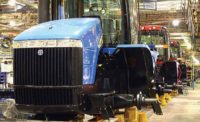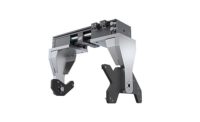Robotics and wrestling have a lot in common. Flexibility and reach are important to both. Robots and wrestlers also have numerous categories that are based on different weight and payload capacities.
The sumo wrestlers of the robotics world are high-payload robots. Those machines boast wide work envelopes and can handle heavy-duty loads.
Today, more manufacturers are investing in giant six-axis robots to take on tasks that were previously performed by forklifts, hoists, lift-assist devices, overhead cranes and other types of material handling equipment.
Big robots are especially popular with manufacturers of cast and forged metal parts. They’re also attractive to companies that need to move automotive floor pans, car bodies, rear-axle assemblies, large household appliances, tractors or other bulky objects, such as sections of airplanes, railcars and ships.
Allied Market Research predicts that demand for super heavy payload robots will grow 4 percent annually between now and 2025. Those types of machines particularly appeal to automotive manufacturers for applications in body shops, foundries and engine or transmission assembly lines.
A good example is Ford Motor Co.’s Michigan Assembly Plant. It uses a heavy-duty six-axis machine that employees affectionately dubbed “Godzilla.” The big robot serves as a vehicle transfer system in the body shop. It precisely picks up bodies off pallets and places them on skids that carry them through the paint shop.
The robot replaced the need for traditional lift and transfer systems that use mechanical tooling. That reduced floor space in the 2012 Assembly Plant of the Year by more than 40 percent. It also decreased system complexity by removing extensive hard tooling. In the past, the transfer process required the use of forklifts and other nonflexible material handling devices.
Flexible Automation
Manufacturers increasingly want to pick up larger and heavier parts with robots. Flexible automation is becoming a more attractive alternative than the fixed monuments of the past.
“Super heavy payload robots are replacing machines that were custom applications typically built for just one dedicated purpose,” says Chris Blanchette, executive director for global accounts at FANUC America Corp. “For instance, automotive assembly plants often used elevators that moved entire car bodies from the factory floor to elevated conveyors.
“Six-axis robots have the flexibility to handle new tasks in the future without having to redesign a machine or reconfigure valuable floor space,” explains Blanchette. “Today’s generation of robots also cost less to integrate into assembly lines.”
According to Blanchette, high payload robots appeal to the logistics and warehousing industry because the machines can pick up large pallets and bulk containers of liquid or powder. In addition, big robots are becoming popular in the construction industry for handing tasks such as moving big loads of bricks, marble blocks, precast concrete slabs or steel beams.
“We’re also seeing a lot of increased demand in the aerospace industry,” says Blanchette. “Aircraft manufacturers rely on large, heavy tooling for assembly applications such as drilling and riveting. Big robots appeal to them because of their large reach capacity and ability to easily work around massive parts. One big robot with a wide work envelope can perform assembly tasks on an entire fuselage section.”
FANUC classifies its R-2000iC and M-900iB families as heavy payload robots, because they can typically handle anything from 200 to 700 kilograms. However, its super heavyweight M-2000iA robot family is the strongest on the market. It can handle payloads up to 2,300 kilograms and boasts a reach of more than 4,600 millimeters.
“High payload robots afford the flexibility in material handling applications that were traditionally handled through lower technology conveyor systems or through great degrees of manual handling,” adds Dean Elkins, segment leader for material handling at the Motoman Robotics Division of Yaskawa America Inc.
“Heavy payload robots allow for the flexible, efficient handling of parts through a variety of processes without the need for human intervention,” says Elkins. “The definition of ‘heavy payload’ is often reserved for robots that can routinely manipulate loads, including the end effector, that exceed 200 kilograms.”
Kawasaki Robotics USA Inc. classifies “heavy” as robots with payload capacities higher than 300 kilograms.
“The flexibility that robots offer compared to hard automation is one of the key reasons heavy equipment industries are seeking heavy payload machines,” notes Samir Patel, director of product and applications engineering at Kawasaki Robotics. “Robots go through rigorous development and testing, which makes them [more] reliable [than fixed automation].
“Another reason for the growing demand of heavy-duty robots is that industries such as aerospace, oil and gas and power generation have more need to handle very heavy payloads for unconventional applications,” claims Patel.
‘Heavy’ Defined
Is bigger better? When it comes to robots, it depends on the application and how you define terms such as “big” or “heavy.”
Comau LLC defines “heavy payload” as robots similar to its new NJ-650 2.7, which boasts a capacity of 650 kilograms and a reach of up to 3 meters. On the other hand, Motoman’s strongest machine is the MH900 robot, which can handle 900-kilogram payloads with 4.6 meters of horizontal reach.
“Ten to 15 years ago, the industry was just beginning to see electric robots that could lift greater than 150 kilograms as the norm,” says Elkins. “Several years ago, the heavy-payload class had a starting point that averaged between 100 and 150 kilograms.
“In fact, some early heavy payload robots were hydraulic,” recalls Elkins. “This changed with the introduction of servomotors and electric drives that had greater output characteristics such as torque. Coupling them with more robust gear reduction systems led the way to the design of robots that could lift and manipulate payloads in excess of 600 kilograms.”
According to Josh Williamson, global product manager at ABB Robotics, a heavy payload robot is anything that’s capable of handling applications of 350 kilograms or more. “This term is relative and there will be many opinions on what is considered heavy payload,” he points out.
“The definition of a heavy payload has changed a lot over the years,” notes Williamson. “In 1991, our IRB 6000 robot weighed about 2,000 kilograms and had a maximum payload of 200 kilograms. That is a 10-to-1 ratio. This was considered a ‘heavy payload’ robot.
“ABB released the IRB 7600 in 2001,” says Williamson. “It was the first six-axis robot with a [capacity] of 500 kilograms, which is still considered heavy payload today. Most people in our industry considered anything above 250 kilograms to be heavy payload 15 years ago.
“Today’s IRB 8700 weighs 4,525 kilograms and has a maximum end-of-arm payload of 800 kilograms,” explains Williamson. “That is better than a 6-to-1 ratio. High-payload robots have become leaner and stronger.”
Most six-axis robots look and perform the same way no matter what their payload capacity is. Big robots are typically scaled up designs of smaller machines that share similar operating characteristics as their little brothers.
“Our heavy payload machines feature bigger gears and larger capacity motors,” says Williamson. “They also use thicker castings capable of withstanding the forces produced by the extreme payload mass that is multiplied by motion, including quick accelerations and decelerations, especially with an emergency stop.”
“The engineering behind the casting designs is a little different than with smaller robots,” adds Eric Potter, director of engineering for general industry and automotive applications at FANUC. “When you have heavier payload robots, you want to maximize casting strength while minimizing robot weight. These innovations in casting designs allow the additional payload to be available to the user on the end of the robot arm, not used internally due to heavier castings.
“Another aspect of weight savings is minimizing motor weight,” explains Potter. "Software innovations have allowed us to have multiple motors synchronized for use on the same axis to maximize power while minimizing the space required.
“Programming and user interaction is basically the same with all of our six-axis robots,” claims Potter. “There’s no difference in user interface experience between machines with different payload capacities. The programming interface on the teach pendant is the same for our super heavy payload M-2000 all the way down to our little LR Mates that handle light loads. This allows users of FANUC robots to easily transition from our lighter payload robots to our heaviest payloads.”
Of course, high payload robots are typically heavier and slower than smaller six-axis machines. “There is a tradeoff between how much you can carry and how fast you can carry it,” notes Potter.
The floor loading unit area is also higher with heavy-payload robots. Therefore, anchoring and foundation requirements must be carefully considered.
“One of the biggest issues with super high payload robots is that you need to have a special foundation poured for it,” says Blanchette. “To address the anchoring issue, our M-2000 series features a balanced load distribution on its base. As a result, the floor foundation does not have to be as thick.”
Big Bots for Big Jobs
A handful of companies make large robots that can handle payloads over 600 kilograms. But, the battle for the super heavyweight title of world’s largest and strongest robot is currently being waged by ABB, FANUC, Kawasaki and KUKA. Those four vendors each make six-axis machines that can accommodate payloads of more than 1,000 kilograms.
Kawasaki’s MG series can handle payloads up to 1,500 kilograms with a reach of 4,005 millimeters. KUKA’s KR 1000 Titan F series boasts a payload capacity of 1,300 kilograms and a reach of up to 6.5 meters.
ABB’s largest robot is the IRB 8700, which has maximum reach of 4.2 meters and a maximum payload of 800 kilograms. However, its payload capacity can be up to 1,000 kilograms with the wrist down.
“The robot automatically adapts and adjusts its speed to accommodate heavy and wide parts,” says Nicolas De Keijser, assembly and test business line manager at ABB Robotics. “It only has one motor and one gear per axis, while most other robots in this size class use dual motors and gears. Fewer components and shorter cycle times make the machine 25 percent faster than any comparable robots in its payload range.”
The undisputed super heavyweight robot is FANUC’s M-2000iA, which is officially recognized by the Guinness World Records under the category of “strongest robot arm.”
"The design of the mechanical unit is important to consider with high-payload robots," says Blanchette. "Our M-2000 will enable full manipulation of heavy payloads. Because of our robust gears and castings, the wrist is strong enough to support a payload in any orientation. However, some of our competitor's machines can only do full payload in a wrist-down configuration."







